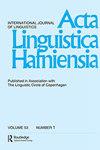Icelandic, Faroese and Greenlandic orientation systems: all absolute?
Q2 Arts and Humanities
引用次数: 3
Abstract
Abstract Orientation systems found around the North Atlantic Rim – those of Greenland, Iceland and the Faroe Islands – have much in common, although two quite unrelated language families are involved. This has much to do with comparable geographical situations and may be taken as supporting Palmer’s Topographic Correspondence Hypothesis. The actual orientation of north–south–east–west terms can vary around the coasts of Iceland and the Faroes as it does around Greenland. All three regions arguably display ‘absolute’ systems, but most noteworthy is the fact that they apply differently at different spatial scales, ranging from the individual house and its surroundings, via specific stretches of coast, up to the broadest frame covering the whole country. The same terms may be used at all levels, only disambiguated by context. There are of course also differences between the systems of the three regions, reflecting their different cultural and technological backgrounds and the geographical alignment of their convoluted coastlines. The question as to whether such systems represent a distinct ‘landmark’ sub-type of absolute system is addressed. It is argued that distinctions of scale are more relevant here than the distinction between ‘cardinal’ and ‘landmark’ sub-types.冰岛、法罗群岛和格陵兰岛的定位系统:都是绝对的?
北大西洋周围的定位系统——格陵兰岛、冰岛和法罗群岛的定位系统——有很多共同点,尽管涉及两个完全不相关的语系。这与可比较的地理情况有很大关系,可以看作是对帕尔默地形对应假说的支持。在冰岛和法罗群岛的海岸周围,北-南-东-西的实际方向可能会发生变化,就像格陵兰岛周围一样。可以说,这三个区域都展示了“绝对”系统,但最值得注意的是,它们在不同的空间尺度上应用不同,从单个房屋及其周围环境,到特定的海岸延伸,再到覆盖整个国家的最广泛的框架。所有级别都可以使用相同的术语,只是根据上下文消除歧义。当然,这三个地区的系统之间也存在差异,这反映了它们不同的文化和技术背景以及它们曲折海岸线的地理排列。关于这些系统是否代表绝对系统的一个独特的“地标”子类型的问题得到了解决。有人认为,尺度的区别在这里比“基数”和“地标”亚型之间的区别更相关。
本文章由计算机程序翻译,如有差异,请以英文原文为准。
求助全文
约1分钟内获得全文
求助全文
来源期刊

Acta Linguistica Hafniensia
Arts and Humanities-Language and Linguistics
CiteScore
0.90
自引率
0.00%
发文量
5
 求助内容:
求助内容: 应助结果提醒方式:
应助结果提醒方式:


